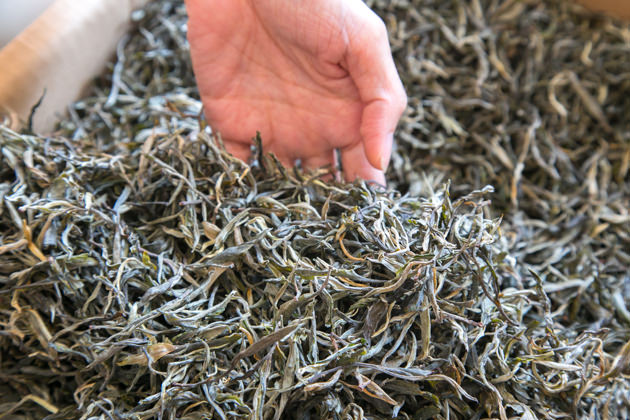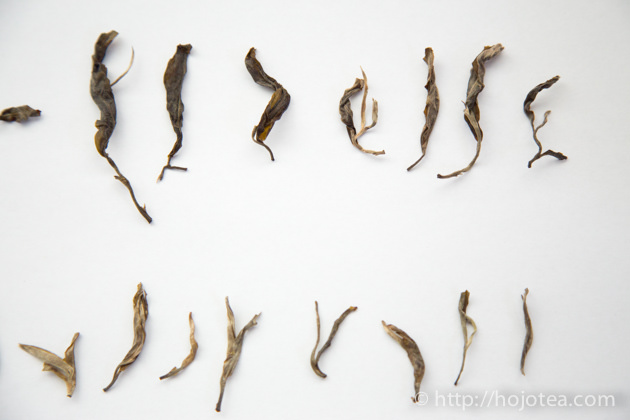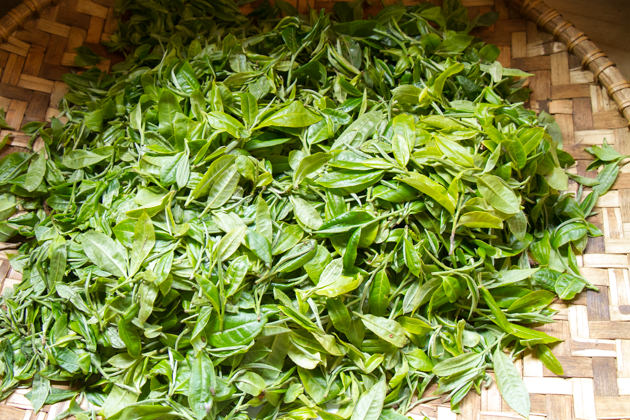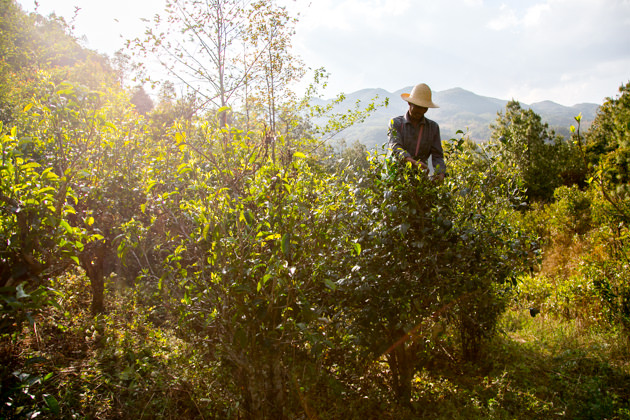- HOME >
- New Arrival at HOJO Online Shop
High Mountain Silver Downy Raw Pu-erh Tea 2014
- [2016.02.09] Posted By Akira Hojo
Tea made from 1 bud and 1 leaf
High Mountain Silver Downy 2014 is made of tea grown in natural farming style. This is a raw pu-erh tea, and as it is, this is a very unusual pu-erh tea. This is because the plucking standard of this tea is “1 bud and 1 leaf”. It is actually a very unusual plucking standard for pu-erh tea. Usually, the common plucking standard of tea leaf for pu-erh tea is very random, normally it is one bud and 2 or 3 leaves. To make pu-erh tea, the more grown-up leaves contain more poly phenols, and it will give a desirable effect in flavor when tea is further matured after a period of time. In HOJO’s tea lineup, most of pu-erh tea follows this standard.
Mao-cha of high mountain silver downy
The top is the common plucking standard, that follows 1 bud and 2-3 leaves and the bottom is the mao-cha of high mountain silver downy that consists of 1 bud and 1 leaf.
Soft mouth feel thanks to 1 bud 1 leaf
In fact, some tea drinkers enjoy the soft mouth-feel. To meet the various preferences of tea drinkers, we have set-up the different plucking standards for making pu-erh tea, white tea and black tea. For example, we use 1 bud and 2 leaves for Yan Ming Shan raw pu-erh tea. This is the reason that Yan Ming Shan gives quite smooth drinking sensation. The High Mountain Silver Downy raw pu-erh tea also gives very soft and creamy texture. It gives natural sweetness like we are drinking a white tea. With less number of leaves, the amino acid in tea bud plays the dominant role in influencing the drinking sensation. The soft mouth-feel is because of richer content of theanine. The theanine also affects the flavor of tea during maturation. The High Mountain Silver Downy develops the flavor reminiscent to sugar cane or brown sugar. Based on our experience, tea will develop the sweet flavor after 3 years of aging onwards.
Time-consuming tea plucking
As high mountain silver downy consists of only 1 bud and 1 leaf, it appears like silivere velvet. In fact, a farmer prefer to wait until tea grows with 1 bud and 2-3 leaves as it is much faster to accumulate the production yield in a day. Comparatively, a farmer has to spend much longer time to collect 1 bud and 1 leaf. Consequently it is reflected in its price.
Tea plucked following the standard of 1 bud and 1 leaf.
Tea plucked following normal standard, 1 bud and 2-3 leaves.
Tea is grown in the mountain located near the Myanmar border.
The High Mountain Silver Downy 2014 is produced in the village located at Lincang, Yunnan in China. The village is located about 20km away from Myanmar border. The tea is collected by the mountain-Thai tribes. The altitude of the tea garden is about 1700m. Tea is not grown in the modern style, but in the form of independent bushes. It is grown in natural farming style; the farmer uses no fertilizer and no pesticide. Due to the remote location, people up there still practice the ancient agricultural method till today.
Related Articles
How to get the latest update on HOJO Tea?
1. Follow Twitter, 2. Click "Like" on Facebook, and 3. Subscribe in newsletter. You can have the latest tea news from HOJO Tea.
 Subscribe the Newsletter to enjoy the privileges
Subscribe the Newsletter to enjoy the privileges- You may receive a free sample upon purchase, or you may have the priority to purchase special products. So please remember to subscribe our newsletter as well as the social network.
- New Release of High Mountain White Tea
- We are pleased to introduce our High Mountain White Tea, sourced from a unique tea garden with two key features: 1. Located at an altitude of 2200-2300m2. Completely wild and untended The ideal natural conditions of this garden result in tea of exceptional quality, offering a pure and gentle, nourishing taste. High Altitude and Wild …
- New Release of Da Xue Shan Wild White Tea 2024
- We have released the 2024 Da Xue Shan Wild White Tea Loose Leaf. This tea was produced under our direct supervision during our stay in Yunnan Province, ensuring meticulous production management on site. Definition of Wild Tea in Yunnan Province People in Yunnan strongly associate Camellia taliensis with wild tea, regardless of where it is …
NEW ARTICLES
 Why Do Some Teas Taste Astringent? Exploring the Causes and Mechanisms of Astringency
Why Do Some Teas Taste Astringent? Exploring the Causes and Mechanisms of Astringency- Tea can range from having no noticeable astringency to possessing a very strong one. What causes this astringency? This article explores the causes and mechanisms behind astringency in tea. Causes of Astringency Astringency arises from the binding of tea components to proteins in the oral cavity, creating a sensation of tightness or dryness. The tongue …
 The Impact of Heat Sources on Tea Flavor
The Impact of Heat Sources on Tea Flavor- It is widely recognized that the material of a kettle plays an important role in shaping the taste of water for brewing tea. Yet, an often overlooked but equally significant factor is the type of heat source used to boil the water. Different heat sources, whether gas, electric, charcoal, or wood fire, can impart distinct …
 New Release of High Mountain White Tea
New Release of High Mountain White Tea- We are pleased to introduce our High Mountain White Tea, sourced from a unique tea garden with two key features: 1. Located at an altitude of 2200-2300m2. Completely wild and untended The ideal natural conditions of this garden result in tea of exceptional quality, offering a pure and gentle, nourishing taste. High Altitude and Wild …
 New Release of Da Xue Shan Wild White Tea 2024
New Release of Da Xue Shan Wild White Tea 2024- We have released the 2024 Da Xue Shan Wild White Tea Loose Leaf. This tea was produced under our direct supervision during our stay in Yunnan Province, ensuring meticulous production management on site. Definition of Wild Tea in Yunnan Province People in Yunnan strongly associate Camellia taliensis with wild tea, regardless of where it is …
 New Release of Wild Pu-erh Jasmine Pearl
New Release of Wild Pu-erh Jasmine Pearl- Out of curiosity, we decided to create a jasmine tea based on Da Xue Shan Wild Raw Tea. This resulted in an exceptionally rare tea, not only in Japan but also in China. Custom Production Network for Jasmine Tea At our store, we source various types of base teas from different regions during the spring. …
 2024 Overview: Our Yunnan White Tea Quality, Process, and Weather Insights
2024 Overview: Our Yunnan White Tea Quality, Process, and Weather Insights- One of the teas we’ve been focusing on in Yunnan Province is white tea. Historically white tea has been produced in both Fujian Province and Yunnan Province for a long time. While white tea from Fujian Province is well-managed during processing, we are dissatisfied with the quality of the raw materials due to the use …
 Yunnan’s Hospitality Culture: Expressed Through Meals
Yunnan’s Hospitality Culture: Expressed Through Meals- In China, as a form of greeting, it’s common to say “你吃饭了吗?” which means “Have you eaten?” However, in Yunnan Province, the phrase “吃饭” is often used in various situations, more like “Eat, eat,” serving as an invitation to share a meal. Yet, with prolonged exposure to Yunnan, one comes to understand that these meal …
 In Search of Wild Tea: Exploring Mountain Villages in Southwest Lincang, Yunnan
In Search of Wild Tea: Exploring Mountain Villages in Southwest Lincang, Yunnan- We are currently sourcing tea in the southwestern part of Lincang City, Yunnan Province. One of the crucial products for us is wild tea. While tea processing is important, securing the raw materials poses the biggest challenge. Recently, we received information about a new location where wild tea supposedly grows. To verify this, we visited …
 New Release of Anxi Traditional Oolong
New Release of Anxi Traditional Oolong- Anxi, located in Fujian province, China, is celebrated for its Tie Guan Yin tea. However, the Traditional Anxi Oolong from this region boasts a unique fruity aroma, distinguishing it from Tie Guan Yin. Anxi: A Renowned Hub for Oolong Tea Production in China Fujian Province, renowned for its rich tea heritage, boasts several prominent tea-producing …
 Yunnan 2024 Spring Tea Sourcing
Yunnan 2024 Spring Tea Sourcing- Yunnan Province is globally renowned for the exceptional quality of its tea leaves. However, lax production management often presents challenges in achieving the desired tea quality when relying solely on pre-made teas. To address this issue, we have committed to remaining on-site throughout the spring season to closely monitor tea production. We are meticulously inspecting …
Shop Info

Address:Lot No. T-215, 3rd Floor, The Gardens Mall, Mid Valley City, Lingkaran Syed Putra, 59200 Kuala Lumpur
Tel: +603-2287-4537
Business Hour: 10am to 10pm
Category
- New Arrival at HOJO Online Shop
- Featured Articles
- Newsletter
- Types of Tea
- Origin of Tea
- Teapot and Tea Equipment
- Tea Column
- How to enjoy tea
- Tea Processing
- How to choose quality tea
- Tea constituents and functional effect
- Safety of Tea
- Foods
- Tea Business Operation
- Hobby and Outdoor Activity
- Ranking of Tea
- Video
- FAQ
- Media Release
Profile

- AKIRA HOJO
- I invite you to experience my tea selections.I was born in Nagano, Japan. In university, I studied agricultural chemistry, and I have the master degree in food science. I worked in Japanese food industry for 10 years. I involved in R&D, QC and QA. As a factory manager, I implemented ISO9000 series and managed the factory.
- The Art of Tea Magazine
- We posted the article on “The Art of Tea Magazine No.9, the magazine is published in Taiwan. We featured some scientific view about the tetsubin
- New Straits Times
- The Malaysian National Newspaper, New Straits Times featured HOJO Tea on 17-Oct-2007.


























